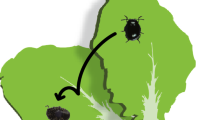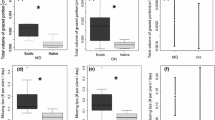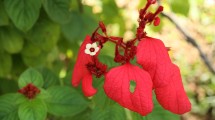Abstract
Common types of plant defense mechanisms are thought to affect the host ranges of polyphagous herbivorous insects, yet few studies have examined the relationship between host plant suitability for polyphagous insects and defense against them. We investigated the suitability of the 19 plant species growing in the habitat of the polyphagous grasshopper, Parapodisma subastris, to determine the relationship between the physical characteristics of leaves and the growth and survival of grasshopper nymphs. We examined leaf toughness, trichome density, and length. Nymph survival was greater on plants with characteristics ranging from soft leaves and dense trichomes to tough leaves and few trichomes than on plants with soft leaves and few trichomes. The exception was Rorippa indica, a plant with soft leaves and few trichomes that uses biotic defense, on which nymph survival was maximal. Higher-quality plants that share common physical characteristics over families may favor polyphagy by grasshoppers that possess ability to overcome the physical defense easily with their robust mandibles.

Similar content being viewed by others
References
Augner M (1995) Low nutritive quality as a plant defence: effects of herbivore-mediated interactions. Evol Ecol 9:605–616
Barbosa P (1988) Some thoughts on “the evolution of host range”. Ecology 69:912–915
Bernays EA (1988) Host specificity in phytophagous insects: selection pressure from generalist predators. Entomol Exp Appl 49:131–140
Bernays EA, Bright KL (1993) Mechanisms of dietary mixing in grasshoppers: a review. Comp Biochem Physiol 104A:125–131
Bernays EA, Chapman RF (1994) Host-plant selection by phytophagous insects. Chapman and Hall, New York
Bernays E, Graham M (1988) On the evolution of host specificity in phytophagous arthropods. Ecology 69:886–892
Bernays EA, Bright KL, Gonzalez N, Angel J (1994) Dietary mixing in a generalist herbivore: tests of two hypotheses. Ecology 75:1997–2006
Chapman RF (1990) Food selection. In: Chapman RF, Joern A (eds) Biology of grasshoppers. Wiley, New York, pp 39–72
Chapman RF, Sword GA (1994) The relationship between plant acceptability and suitability for survival and development of the polyphagous grasshopper, Schistocerca americana (Orthoptera: Acrididae). J Insect Behav 7:411–431
Coley PD, Bryant JP, Chapin FS III (1985) Resource availability and plant antiherbivore defense. Science 230:895–899
Dethier VG (1954) Evolution of feeding preferences in phytophagous insects. Evolution 8:33–54
Ehrlich PR, Murphy DD (1988) Plant chemistry and host range in insect herbivores. Ecology 69:908–909
Ehrlich PR, Raven PH (1964) Butterflies and plants: a study in coevolution. Evolution 18:586–608
Feeny P (1970) Seasonal changes in oak leaf tannins and nutrients as a cause of spring feeding by winter moth caterpillars. Ecology 51:565–581
Feeny P (1975) Biochemical coevolution between plants and their insect herbivores. In: Gilbert LE, Raven PH (eds) Coevolution of animals and plants. University of Texas Press, Austin, pp 3–19
Feeny P (1976) Plant apparency and chemical defense. Recent Adv Phytochem 10:1–40
Fox LR (1988) Diffuse coevolution within complex communities. Ecology 69:906–907
Fox LR, Morrow PA (1981) Specialization: species property or local phenomenon? Science 211:887–893
Freeland WJ, Janzen DH (1974) Strategies in herbivory by mammals: the role of plant secondary compounds. Am Nat 108:269–289
Fry JD (1996) The evolution of host specialization: are trade-offs overrated? Am Nat 148:S84–S107
Hanley ME, Lamont BB (2002) Relationships between physical and chemical attributes of congeneric seedlings: how important is seedling defence? Funct Ecol 16:216–222
Joern A (1979) Feeding patterns in grasshoppers (Orthoptera: Acrididae): factors influencing diet specialization. Oecologia 38:325–347
Joshi A, Thompson JN (1995) Trade-offs and the evolution of host specialization. Evol Ecol 9:82–92
Levin DA (1973) The role of trichomes in plant defense. Q Rev Biol 48:3–15
MacFarlane JH, Thorsteinson AJ (1980) Development and survival of the two striped grasshopper, Melanoplus bivittatus (Say) (Orthoptera: Acrididae), on various single and multiple diets. Acrida 9:63–76
Marquis RJ (1992) Selective impact of herbivores. In: Fritz RS, Simms EL (eds) Plant resistance to herbivores and pathogens: ecology, evolution, and genetics. The University of Chicago Press, Chicago, pp 301–325
Mauricio R (1998) Costs of resistance to natural enemies in field populations of the annual plant Arabidopsis thaliana. Am Nat 151:20–28
Miura K, Ohsaki N (2004) Diet mixing and its effect on polyphagous grasshopper nymphs. Ecol Res 19:269–274
Miyatake Y, Kanô Y (1992) Semi batta (in Japanese). Hoikusha, Osaka
Otte D (1975) Plant preference and plant succession: a consideration of evolution of plant preference in Schistocerca. Oecologia 18:129–144
Pulliam HR (1975) Diet optimization with nutrient constraints. Am Nat 109:765–768
Schoonhoven LM, Jermy T, von Loon JJA (1998) Insect-plant biology: from physiology to evolution, Chapman and Hall, London
Strong DR, Lawton JH, Southwood TRE (1984) Insects on plants: community patterns and mechanisms. Blackwell, Oxford
Sword GA, Chapman RF (1994) Monophagy in a polyphagous grasshopper, Schistocerca shoshone. Entomol Exp Appl 73:255–264
Thompson JN (1994) The coevolutionary process, University of Chicago Press, Chicago
Westoby M (1978) What are the biological bases of varied diets? Am Nat 112:627–631
Yano S (1994) Flower nectar of an autogamous perennial Rorippa indica as an indirect defense mechanism against herbivorous insects. Res Popul Ecol 36:63–71
Acknowledgments
We thank Dr. E. Kuno for his encouragement and Dr. T. Nishida for critical comments on this manuscript.
Author information
Authors and Affiliations
Corresponding author
Additional information
An erratum to this article can be found at http://dx.doi.org/10.1007/s10144-004-0203-y
Rights and permissions
About this article
Cite this article
Miura, K., Ohsaki, N. Relationship between physical leaf characteristics and growth and survival of polyphagous grasshopper nymphs, Parapodisma subastris (Orthoptera: Catantopidae). Popul Ecol 46, 179–184 (2004). https://doi.org/10.1007/s10144-004-0177-9
Received:
Accepted:
Published:
Issue Date:
DOI: https://doi.org/10.1007/s10144-004-0177-9




